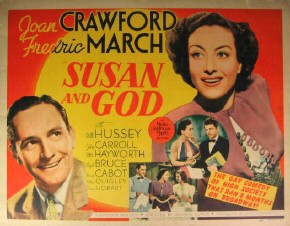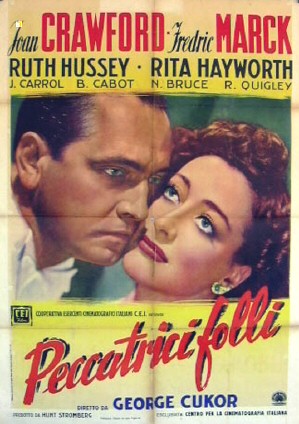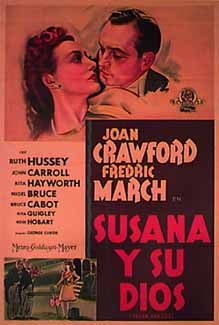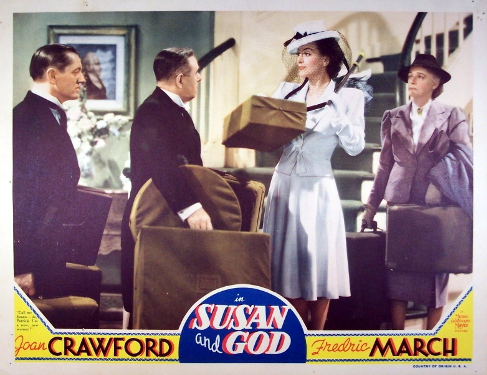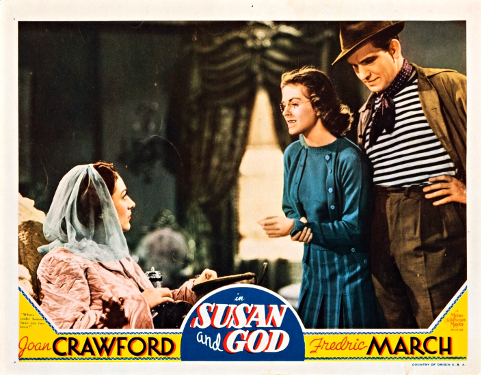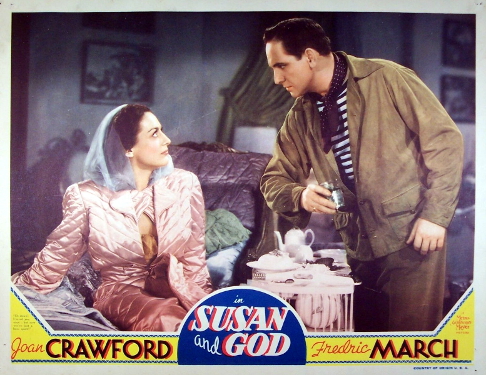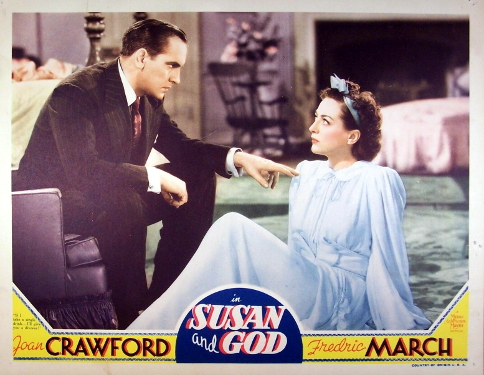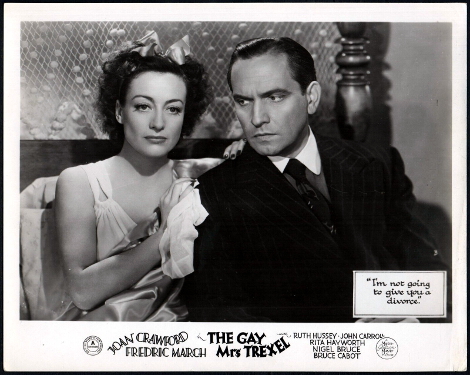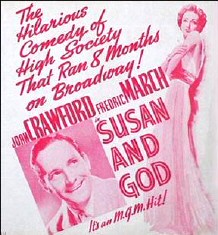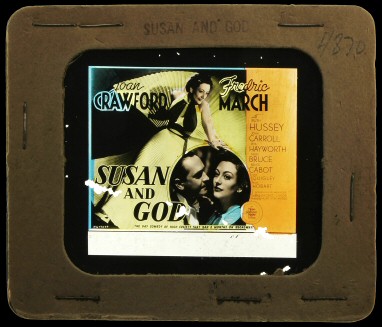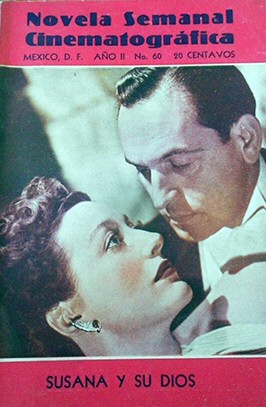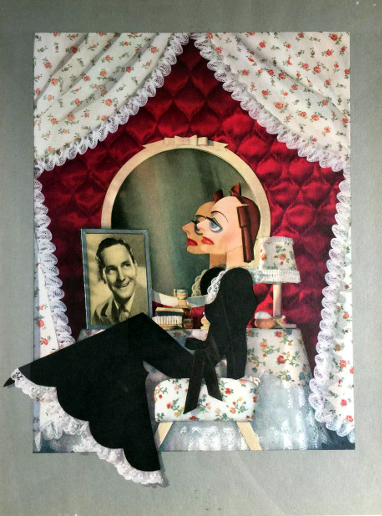|
 Tom C. (October 2024) Tom C. (October 2024)
Rating:   of
5 of
5
Joan
once said, "I'd play Wally Beery's grandmother if it was a good part." With due respect to Beery's grandma, who died long before
Susan and God (1940) was released, Joan should have passed on
this Norma Shearer reject. Not her best or most endearing role.
Joan/Susan harangues everyone with the zeal of the newly converted, and it
is also implied she's driven her husband Barrie (played by Fredric
March) to drink.
At the outset, we see Susan
returning home after a long European
sojourn, ditching family to be with friends and, for the first half of
the film, breathlessly inflicting her newfound philosophies upon them. After this, said friends disappear and
S&G transitions to a domestic affair. Husband Barrie
and teenage daughter Blossom (Rita Quigley) long to be a normal family. Barrie gives
up booze, and Joan helps ugly-duckling Blossom "shed those dowdy
feathers and fly." I enjoyed this part
of the film. However, the
eventual denouement doesn't flatter Susan, even with a standard
Hollywood happy ending.
Fredric March was an actor with a long,
successful career, from an Oscar-winning performance in
Dr. Jekyll and Mr. Hyde (1931) to the excellent Inherit the Wind (1960). He delivers the best performance in
Susan and God. Rita Quigley,
who had only a short film
career, was one of any of MGM's child stars who could have played this role.
Much
of the supporting cast, as mentioned above, disappear after Susan's
zealotry drives them away. Notable are Nigel Bruce and a young Rita
Hayworth (gorgeous!), still a few years from stardom. Ruth
Hussey plays Charlotte, who has long carried a torch for Barrie but
isn’t given much to do.
Throughout,
I felt there was an inside joke I wasn't privy to. Doing a little
reading, it seems this movie was a poke at the Oxford Group, a religious movement most
popular in the 1930s, which
preached self-revelation, making amends,
etc. Susan's major act upon revelation is that she dyes her hair---not exactly
expunging one's soul. As husband Barrie says, she's into it more for style than
substance.
That Susan and God is a cinematic miss is disappointing given that Joan bookended it with two of her strongest MGM efforts:
Strange Cargo preceded it, and A Woman's Face followed.
Directing is George Cukor, whose other
collaborations with Joan (including The Women and A Woman's Face)
are classics; this is not. Joan said in
“Conversations” that she was not sure how to play Susan,
but a meeting with Cukor set her straight. I'm not sure what George
said, but it didn't work for me. From contemporary reviews, it seems Joan
was channeling Gertrude Lawrence, who made the role of Susan Trexel a
hit on Broadway. So maybe that was Cukor’s advice?!
Moreover, a strong team was behind the camera. And
Rachel Crothers, a top
playwright, provided the source material for this film. (Crothers' plays
were the basis for two other Joan films: When Ladies Meet [1941] and No More Ladies
[1935]). The screenplay was credited to Anita Loos, who was responsible for enlivening
The Women (1939) with top-notch dialog that makes it a classic.
There is no such zing here.
 Stephanie
Jones (June 2023) Stephanie
Jones (June 2023)
Rating:    - 1/2 of 5 - 1/2 of 5
From
the second she steps off the boat for a weekend with her society
friends, Joan's "Susan" is a glittery whirling dervish of newfound
religious enthusiasm, much to the dismay of her still-jaded companions.
Susan's misguided attempts at converting these "worldlings" are the high
point of the movie. The excellent supporting characters, played by Ruth
Hussey, Nigel Bruce, Rose Hobart, and Rita Hayworth, et al, are all
wittily horrified at her meddling in their personal lives, and these
scenes zip along with style and verve.
Joan doesn't really have a
light comedic touch here, as someone like Carole Lombard might have
brought to the role; rather, her Susan is quite high-strung, jittery,
feral even---never, even in her earlier flapper roles, have I seen her
this jumpy, and her rapid-fire delivery and intensity in these early
scenes is decidedly unusual for her and will probably be especially
fascinating for Joan devotees.
Things do slow down in the movie's
second half once Susan's relations with her alcoholic husband (Fredric
March) take center stage, and the storyline then shifts to focus on the
rather trite lesson Susan must learn that "family comes first." Not a
knock on March, or Rita Quigley, who plays their daughter Blossom---both
are quite subtle and sensitive as the neglected family members. It's
just that Susan's earlier repartee with her friends is much more
interesting than seeing Blossom, er, blossom under Susan's newly
discovered mothering skills. Director George Cukor also seems to lose a
bit of steam in the second part of the film---there are several scenes
and shots that linger too long without purpose.
Overall, though, I'd
recommend -- a "4+" for the snappy first half, and a 2+
for the duller but still well-acted second half. (With kudos, as always,
to the cantankerous Marjorie Main as the family's surly, sassy
housekeeper.)
 Michael Lia (January
2010) Michael Lia (January
2010)
Rating:   -1/2 of
5 -1/2 of
5
Why shouldn’t Miss Crawford act her role like Gertrude Lawrence from the original stage play? Bette Davis played her pitch the way Tallulah Bankhead played The Little Foxes on Broadway. So there!
The
film is dangerous because I have lost an audience instantly, especially
the opening with Miss Crawford chattering away in God-awful
costumes. I have also had a roomful of people enchanted during the
entire film! Personally my biggest regret is that my partner absolutely
cannot stand this film. It has become a sort of joke and a weapon. I
can use the film as a vendetta or as a threat. Kind of like Gable’s Parnell. Carole Lombard gave him hell about that flop.
Susan
and God is not a flop. It is just plain talky and stagey. Mr. Cukor
certainly was snoring when he was near the camera. However, I will agree
with most critics of the day that the fascination of this film is the
transformation of Miss Crawford from actress glamour-gal to character
actress. It is quite a transformation, considering her past roles and
past career highlights. She swoops in on this one. It is no fault of
Miss Crawford that neither Cukor nor Miss Anita Loos favor the script or
her character or the paying audience to any real satisfaction. This
time his stage background got in the way, and Miss Loos was working
against some odds. She does manage some fun dialogue, but the spark is
not always there.
MGM
must have respected her talent enough to let her loose once in a while,
but remember it is all about the dollar. Miss Crawford can still rake
it in. Therefore
the film was given all the touches of her past films, with the best
available crew and technicians and administrators. This time she is
getting the “Greer Garson” treatment --
formerly the Norma Shearer treatment, formerly the Greta Garbo
treatment. (Miss Garson will find out the same thing, basically
disappearing after 1946.) The top-notch producer will gloss this film
over with super MGM gloss.
Miss
Crawford looks beautiful and radiant. The cameraman adores her even if
the script does not; the clothing adores her if you can get used to
some of the wackier outfits. Some outfits are very elegant -- love the outfit
she wears to the train station, which adds to the dramatic situation and
shows off her face as something like a statute…Hedy Lamarr really has nothing on Miss Crawford.
Fredric
March is excellent, even if he is downplaying; I like the guy and it is
different casting and a nice change of pace. His scenes with the
daughter, played by Rita Quigley (who I honestly know nothing about and
I never see her in anything) -- their scenes are mushy and I am sure Mr.
Mayer cried when he saw them. They do give a few heart tugs to the
story.
The
supporting cast is out of this world; they are a bonus and it is fun to
watch these expert performers, most of whom are all from the stage, work
with Little Miss Motion Picture Star. The thing you have to admire
about Miss Crawford the most is that she was not afraid to take chances
and she could hold her own with the most talented of performers and
actors. She can match them all and that takes confidence and talent:
Rose Hobart (Dr. Jekyll and Mr. Hyde) is
a truly excellent stage actress and never used properly or for long by the studios. She is class, and I am glad she dumps Bruce Cabot (King Kong)
-- he just always seems a little sleazy to me and I never liked him after I found out he sued Errol Flynn in the late 50s.
Nigel Bruce (Sherlock Holmes, Suspicion) is amazing and a comfort; he can make a placemat exciting.
The fact he plays Rita Hayworth’s
old husband is pretty funny, but I guess plausible since these folks are
the idle rich, and I have seen plenty of those relationships. Miss
Hayworth had just appeared with Cary Grant and Jean Arthur in Only Angels Have Wings(1939). Her career is given the preparation once given to Miss Crawford;
she is being groomed for the “big time” and hopefully taking lessons
from Crawford
on how to hold her own. She makes the most out of her tiny role. I am
sure Mr. Cukor spent some extra time with her, and it pays off in the
near future!
Ruth Hussey
is the most interesting person in the film and she has always been a
splendid and alluring actress. She reminds me of Joan Bennett in some
of her delivery. I wish the studio gave her more chances; she would have
knocked us out! She is wonderful in The Philadelphia story and The Uninvited. Her greatest success came from the stage, however.
Marjorie Main:
do I have to say anything? Other than Ruth Hussey, she is the most
exciting character and she is so good in her few moments, being very
snide and sure of herself and wise to Susan and her antics; she can act
with just an eyebrow and she gets her point across with the slightest
stinging tone in her voice.
Susan and God’s
success is because of Miss Crawford (as much as you may want to slap
her on the head sometimes) and MGM’s stock players, who might have had
to hit themselves on the head getting a paycheck this way, having fun
nonetheless. Remember, making films was still fun then.
The best remark about this film is from Ida Lupino, who said:
“I was just watching Susan and God with that Joan Crawford and do you know something? She gets billing over Fredric March and God!"
Way to go Joan!
|
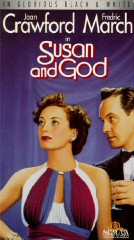
 MGM. 117 minutes.
MGM. 117 minutes.
 Tom C. (October 2024)
Tom C. (October 2024)
 Michael Lia (January
2010)
Michael Lia (January
2010)

